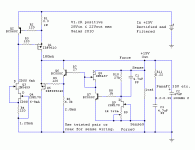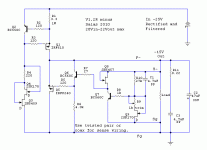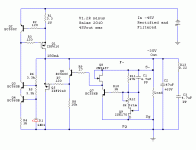Yes... I understand that we must not use Rubycon ZA/L there but Silmics and cerafines might do good.
Silmic has that wonderfull bass / upper bass but adds some grit to the sound.... Cerafines might be very good.
As for the BG.... it is still burning and getting better over time so I will wait.... nevertheless BG are almost unobtainium so we must search elsewhere.
Ricardo, Michael Percy Audio U.S.A. still have BG 47uF
160V VK series
16V FK
25V PK
16V, 50V & 100V Standard
I am already working on that.
i am actually using BG for the 47u but I will also experiement with Silmic II and Cerafines.
For the film I will try Mundorf MKP, Sonicap and Audyn cap.
With these I will be able to determine subjective individual effects so everyone can "cook" the pretended result.
Hi Felipe..... I had some difficulties implementing V12 because the distance between Film output cap and the Mosfet is critical but This one is as stable as V1 and perfectly noiseless... And the gains in detail relative to V1 are substantial.
Hi Ricardo, if you can afford 1uF 400VDC try Sonicap teflons or parallel two 0.47uF FT-3 russian teflons, for 10uF my first choice is MKP non inductive Auricap
An externally hosted image should be here but it was not working when we last tested it.
An externally hosted image should be here but it was not working when we last tested it.
Ricardo, as you know (sent before by p.m.) these are the russian FT3 0.47uF 200VDC
An externally hosted image should be here but it was not working when we last tested it.
Hey Nick, what are these black things on top caps?
An externally hosted image should be here but it was not working when we last tested it.
Some audiophile reminiscences🙂
Just normal electrician's insulation tape. One cap blue the other red, I gave them a common color top not to look too ugly in contrast.😀
Just normal electrician's insulation tape. One cap blue the other red, I gave them a common color top not to look too ugly in contrast.😀
I supposed was a special carbon/titanium/teflon alloy to damper the caps(hey only I'm joking)🙂
So you don't share opinion abount colour LEDs with colours tape caps😀
Nick you have PM
It is best productive to play with design, than with materials. I forgot to tell that I blow a special gas over it and then it sounds magic though.😀
Both are necessary: design & materials to reach our Nirvana but I agree with you: I prefer good design over good materials, always when you have a good design can upgrade to good materials😀
I supposed that you cryogenized the tape & used a special polymer used by NASA....I never suspected that you used a special gas....
I supposed that you cryogenized the tape & used a special polymer used by NASA....I never suspected that you used a special gas....
Last edited:
Hi Ricardo, if you can afford 1uF 400VDC try Sonicap teflons or parallel two 0.47uF FT-3 russian teflons, for 10uF my first choice is MKP non inductive Auricap
An externally hosted image should be here but it was not working when we last tested it.
Where did you get the Sonicap ?
The white "normal" sonicap sound better than also white "normal" Mundorf MKP.
Where did you get the Sonicap ?
The white "normal" sonicap sound better than also white "normal" Mundorf MKP.
Here Platinum series teflon: Sonicap Platinum
I suppose do you refer to Sonicap Gen I?
An externally hosted image should be here but it was not working when we last tested it.
I love caps too
Last edited:
Yes.... Those white sonicaps are really excelent.... Similar tone to Mundorf MKP but without the trebble grit.
He substituted for BC546 he wrote. With 70Vin 50Vout and his current given his voltage over R15 1k in the source he must be having around 40V across Q9 and 50mW I would estimate.
the problem is that the resistor ladder fixes the emitter of Q9 @ ~24V.
The supply rising to 80Vdc, when mains is high, puts a high Vce across Q9.
I do not think he realises that.
Changing the ratios of the resistor ladder could help alleviate that problem, or simply looking at the range of worst case supply voltages that one expects the circuit to survive with.
The supply rising to 80Vdc, when mains is high, puts a high Vce across Q9.
I do not think he realises that.
Changing the ratios of the resistor ladder could help alleviate that problem, or simply looking at the range of worst case supply voltages that one expects the circuit to survive with.
By stating he put BC546 there (Vceo=65V), he must have had it in mind?
...and a few modifications for the higher Vin - 6.8k R14 and R4, changed Q9 and Q2 to BC546C from BC550C,...
Ken
By stating he put BC546 there (Vceo=65V), he must have had it in mind?
Hi Salas and Andrew,
Thanks for your help and thoughts. I turned the Vout up to 60, it took a while ( 10 minutes or so) for the Vout to stop climbing up. I adjusted it back down to 60 several times. Measured temp at Q1 at about 50 deg C and the second mosfet at almost 60 deg C. My heat sink was definately warm and is probably too small.
The LED glowed normally. I will hook the shunt up to the scope tonight and see if its oscillating.
Yes, I was concerned that I would exceed the Vceo of Q9 hence the BC546.
Ken
the cascode (q9) will remove much of the temperature variation in the CCS due to mains voltage changes.
The drift you have found must then be in the Shunt stage or the series FET.
Big sinks will have a profound effect on reducing temperature drift with mains variation.
Further "warm up" drift will tend to zero since the CCS passes by definition constant current.
The drift you have found must then be in the Shunt stage or the series FET.
Big sinks will have a profound effect on reducing temperature drift with mains variation.
Further "warm up" drift will tend to zero since the CCS passes by definition constant current.
Yes.... Those white sonicaps are really excelent.... Similar tone to Mundorf MKP but without the trebble grit.
Platinum teflons maximum value only to 1uF but 0.047uF for RIAA must be excellents🙂.
I went back into the simulation and looked at some of the heat dissipation issues and realized that I have been underestimating just how hot this thing will get. So, several of my concerns were unfounded. For example at this voltage with 100ma load and 200ma current, the shunt mosfet makes over 14w of heat. And my 1k load resistor makes 3.6w of heat. I'm going to take it back to 130ma of current by changing the 3.3 ohm to 5 ohm and see if that doesn't solve some of voltage rise issues.
Ken
Ken
Platinum teflons maximum value only to 1uF but 0.047uF for RIAA must be excellents🙂.
Might be good but we must consider the size... and the cost.
- Status
- Not open for further replies.
- Home
- Amplifiers
- Power Supplies
- The simplistic Salas low voltage shunt regulator



